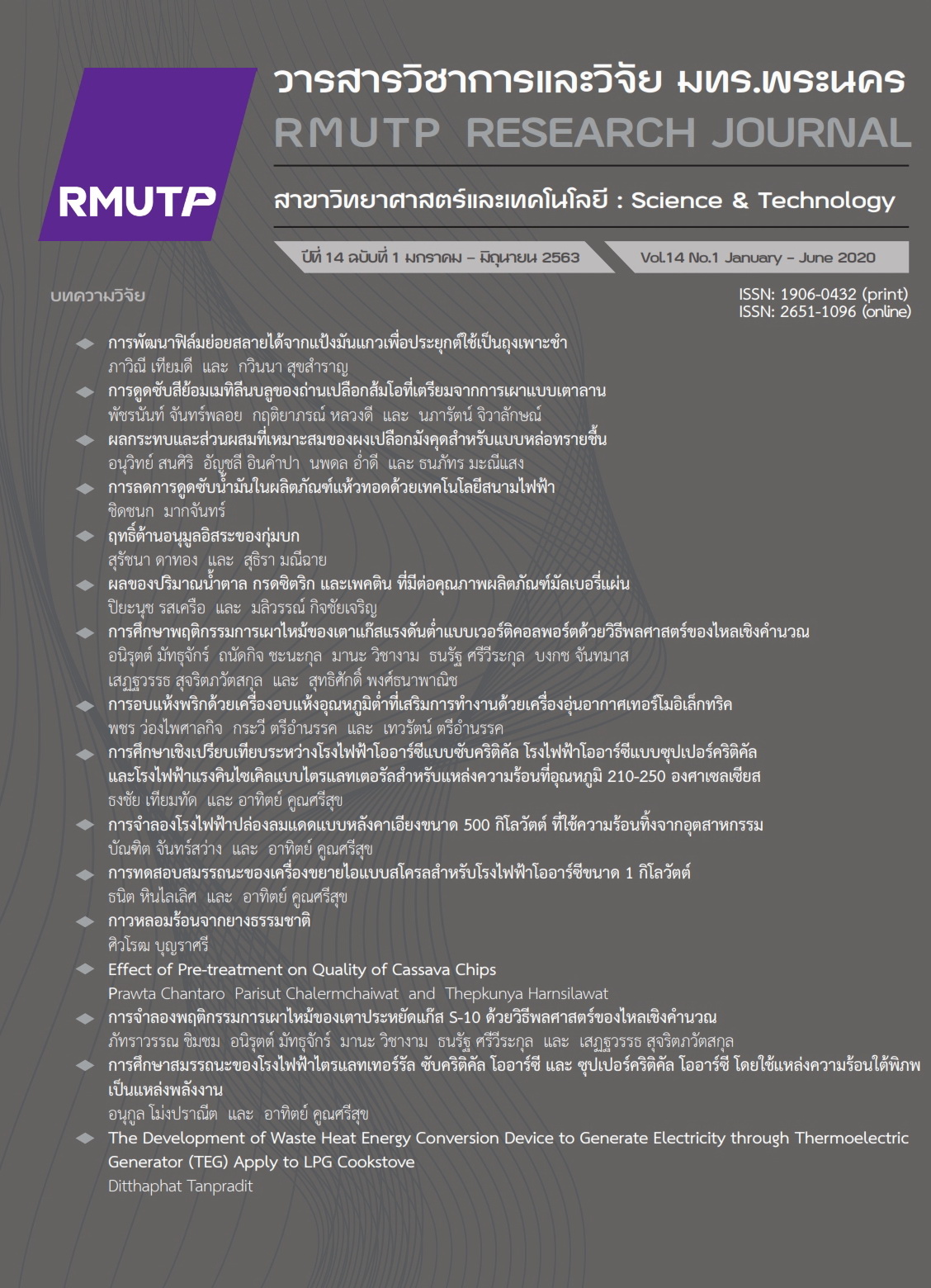การดูดซับสีย้อมเมทิลีนบลูของถ่านเปลือกส้มโอที่เตรียมจากการเผาแบบเตาลาน
Main Article Content
บทคัดย่อ
งานวิจัยนี้ได้ศึกษาการดูดซับสีย้อมเมทิลีนบลูของถ่านเปลือกส้มโอที่เตรียมได้จากการเผาแบบเตาลาน
ได้ทำการศึกษาปัจจัยที่มีผลต่อการดูดซับที่อุณหภูมิห้อง ได้แก่ ระยะเวลาในการดูดซับ และความเข้มข้นเริ่มต้นของสีย้อมเมทิลีนบลู จากการศึกษาผลของระยะเวลาในการดูดซับ พบว่า การดูดซับเกิดขึ้นเร็วในช่วงแรก และเริ่มคงที่ที่เวลาการดูดซับ 24 ชั่วโมง และเมื่อศึกษาความเข้มข้นเริ่มต้นของสีย้อมเมทิลีนบลู พบว่า การเพิ่มความเข้มข้นเริ่มต้นมีผลทำให้ตัวดูดซับเกิดการดูดซับสีย้อมเพิ่มขึ้นอย่างรวดเร็วในช่วงแรก และเมื่อความเข้มข้นเริ่มต้นมากกว่า 600 มิลลิกรัมต่อลิตร พบว่า การดูดซับสีย้อมของตัวดูดซับเพิ่มขึ้นน้อยมาก การศึกษาจลนพลศาสตร์การดูดซับ พบว่า ข้อมูลจากการทดลองมีความสอดคล้องกับแบบจำลองสมการปฏิกิริยาอันดับสองเทียม และไอโซเทอมการดูดซับเป็นไปตามแบบจำลองแลงเมียร์ เป็นการดูดซับแบบชั้นเดียว โดยมีความสามารถในการดูดซับสูงสุด 166.67 มิลลิกรัมต่อกรัมของถ่านเปลือกส้มโอ นอกจากนี้ได้ศึกษาการดูดซับสีย้อมเมทิลีนบลูของถ่านเปลือกส้มโอเทียบกับวัสดุดูดซับชนิดอื่นๆ ที่สภาวะเดียวกัน พบว่า ถ่านเปลือกส้มโอมีความสามารถในการดูดซับสูงกว่าเปลือกส้มโอแห้งซึ่งไม่ผ่านการดัดแปร อีกทั้งยังมีความสามารถในการดูดซับสูงกว่าถ่านถ่านต้นลำไย ถ่านอัดแท่งกะลามะพร้าว ถ่านต้นลิ้นจี่ และถ่านต้นมะขาม ตามลำดับ
Article Details
References
X. Liu, Z. Ni, C. Xie, R. Wang and R. Guo, “Controlled synthesis and selective adsorption properties of Pr2CuO4 nanosheets: a discussion of mechanism,” Nanoscale Research Letters, vol. 13,
no. 268, pp. 1-11, 2018.
K. K. Upadhyay, A. C. Pandey and J. Manzoor, “Impact of dyes on the chemistry of water and its implications: a review,” Bio Bulletin, vol. 3, no. 1, pp. 1-7, 2017.
W. Sarakarnkosol, “Pollution and the dangers of waste water from dyeing clothes,” Environment Journal, vol. 21, no. 1, pp. 7-14, 2017.
Z. Wang, M. Xue, K. Huang and Z. Liu, “Textile Dyeing Wastewater Treatment,” in Advances in Treating Textile Effluent, P. Hauser, Ed. China: InTech, 2011, pp. 91-116.
E. A. S. Almaamary, S. R. S. Abdullah, H. A. Hasan, R. A. Ab. Rahim and M. Idris, “Treatment of methylene blue in wastewater using Scirpus grossus,” Malaysian Journal of Analytical Sciences, vol. 21, no. 1, pp. 182-187, 2017.
J. Thuanthong, “Removal of reactive dye wastewater by chemical coagualation,” M.S. thesis, Dept. Environ. Eng., Chulalongkorn Univ., Bangkok, Thailand, 2010.
P. Jitto, T. Chaikratang and W. Nakbanpote, “Silk textile wastewater treatment by electrocoagulation process,” Journal of Research Unit on Science, Technology and Environment for Learning, vol. 7, no. 2, pp. 228-239, 2016.
T. Kritsanapuk and C. Jarusutthirak, “Decolorization of Synthetic Dyeing Wastewater by Catalytic Ozonation,” in Proceeding of The 54th Kasetsart University Annual Conference, Thailand, 2016, pp. 1107-1114.
R. Srimoon, “Dyes treatment in wastewater using adsorption processes,” KKU Science Journal, vol. 44, no. 3, pp. 419-434, 2016.
M. Kaykhaii, M. Sasani and S. Marghzar, “Removal of dyes from the environment by adsorption process,” Chemical and Materials Engineering, vol. 6, no. 2, pp. 31-35, 2018.
Ministry of Agriculture and Cooperatives. (2019, October). Agricultural Production. [Online]. Available: http://www.agriinfo.doae
.go.th
O. I. Aruoma, B. Landes, D. Ramful-Baboolall, E. Bourdon, V. Neergheen-Bhujun, K-H. Wagner and T. Bahorun, “Functional benefits of citrus fruits in the management of diabetes,” Preventive Medicine, vol. 54, Supplement, pp. S12-S16, 2012.
M. Fatiha and B. Belkacem, “Adsorption of methylene blue from aqueous solutions using natural clay,” Journal of Materials and Environmental Science, vol. 7, no. 1, pp. 285-292, 2016.
C. Umpuch and S. Sakaew, “Removal of methyl orange from aqueous solutions by adsorption using chitosan intercalated montmorillonite,” Songklanakarin Journal of Science and Technology, vol. 35, no. 4, pp. 451-459, 2013.
N. Jiwalak, S. Rattanaphani, J.B. Bremner and V. Rattanaphani, “Equilibrium and kinetic modeling of the adsorption of indigo carmine onto silk,” Fibers and Polymers, vol. 11, no. 4, pp. 572-579, 2010.
U. Gecgel, O. Uner, G. Gokara and Y. Bayrak, “Adsorption of cationic dyes on activated carbon obtained from waste Elaeagnus stone,” Adsorption Science & Technology, vol. 34, no. 9-10, pp. 512-525, 2016.
K. A. Kareem, “Removal and recovery of methylene blue dye from aqueous solution using Avena fatua seed husk,” Ibn Al-Haitham Journal for Pure and Applied Science, vol. 29, no. 3, pp. 179-194, 2016.
R. Saadi, Z. Saadi, R. Fazaeli and N. E. Fard, “Monolayer and multilayer adsorption isotherm models for sorption from aqueous media,” Korean Journal of Chemical Engineering, vol. 32, no. 5, pp. 787-799, 2015.
A. Ritthichai and S. Muncharoen, “Dye removal of textile wastewaters using crab shell activated carbon,” Burapha Science Journal, vol. 19, no. 1, pp. 131-140, 2014.
S. Rattanapan and P. Kongsune, “Methylene blue adsorption onto activated charcoal prepared from mangosteen peel,” Thaksin University Journal, vol. 21, no. 2, pp. 51-59, 2018.
K. Yothawong, L. Singngao, and W. Pongpatrakant, “Preparation of activated carbon from macadamia nut shells by sodium chloride,” in Proceeding of The 1st Loei Rajabhat University Annual Conference, Thailand, 2019, pp. 35-44.

